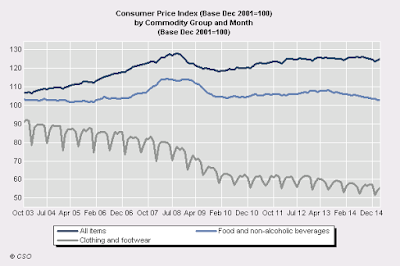A major reason why there has been no rise in inflation is the low or no rises in wages. Workers will now demand a share in the rising economic growth. Irish growth is very strong and the fastest in Europe. Most of the benefit is going to the owners of capital.
It can be seen that prices at the beginning of this year are the same as they were at the beginning of 2008, seven years ago. Prices for all items rose slightly from Q1, 2008 to peak in October 2008.
Prices then fell by a substantial 7.7% between then and January 2001. They have since risen a little and are at the same level in April 2015 as in March 2012 - that is for a three full years and a month, but with some small fluctuations. Prices fell by 0.7% in the past year to April 2015.
Food and (non-booze) drink prices fall slightly over 11 years
The following graph shows the overall trend in prices over the last decade (same as above) compared to the rise in the cost of food and non-alcoholic drink. It can be seen that food and this type of drink is lower today than it was back at the end of 2003. Overall prices rose substantially between then and the peak in June 2008, as we saw.
Food makes up 12% of the average person’s spending in Ireland per the CSO surveys.
The spending on booze is 5.3% of spending of Irish consumers.
Clothing Falling in Price – substantially
The next graph shows something even more interesting on prices. It shows overall price movements and food and drink as in the above graph, but also clothing. What is remarkable is the continuous fall in the price of clothing.
Virtually all clothing is made in developing countries. Major employment firms in clothing and textiles here just 30/40 years ago have shifted offshore or closed down. Happily such firms have been replaced with higher-end production in pharma, food and ICT.
At the start of the graph in end 2003, clothing was already down at 90 of the base of 100 in December 2001. By the end of last year it was at almost half of what it had been in the base year in 2001. This was a fall in clothing prices by almost half in just eleven years.
So its great for Irish shoppers that the price of clothing - much of which is made in Asia and north Africa – has fallen so fast.
And food and drink (not booze) is also falling and has been for some time, but what is rising? Goods are falling with offshoring and better production methods but in general it’s the prices of services which are rising.
Education Rising
First most goods have been falling in price. But most services have been rising. The fastest is education. Here is how it did in this period.
You can see a shocking rise in the cost of Irish education while food and clothing have fallen. While overall prices have been stable in the past 7 years, education rose substantially.
Education is 2.6% weighting in the whole index and of it, third level makes up 65% of educational costs. So it is the rises in college costs including both the public and the private educational sector.
Drink and Government Tax Policy
The price is alcoholic drink rose substantially in the 11 year period as the next graph shows. The government is the big factor in the price of booze and tobacco. Interestingly it did not put up taxes very much during much of the bubble. It only began to increase taxes on these products at the beginning of 2007.
Then taxes and the overall prices stabilised from the beginning of 2009 to end 2012, but have risen substantially since, with a lull in the last year or so. The rise from end 2012 to March 2014 was almost 10%, with a fractional rise since.
Eating Out
There are 12 categories in the shopping basket and the biggest is surprisingly hotels and restaurants which of course includes fast food. Irish people are eating out a lot more than ever, which may be a contributor to growing obesity. It makes up 17% of the total closely followed at 16% by housing, gas, electricity and other fuels and dare I say it, water.
Irish Prices have risen much slower than in EU.
On the base year 2005, prices here (based on the HICP which is slightly different than the CPI used above) have risen by only 9.4% compared to 21.3% for the 27 member states. This is good because the price levels here were much higher than in most EU countries, being second only to Denmark for many years. The stagnation in Irish consumer prices means that we are drawing closer to the EU average price levels, (perhaps examined in another Blog?).
Latvia has seen prices rise by a massive 49% in the decade, followed by Estonia at 45% with Bulgaria at 42% and Lithuania at 40%. Joining the EU did a lot for these countries’ inflation! Happily Poland saw prices rise only slightly above the average at 25% in the decade.
Conclusion
The slow rise in Irish consumer prices has been due to many factors but low wage increases have contributed much.
It looks likely that the European leadership (?) will continue to lurch from one crisis to another and seem incapable of organising a real stimulus plan to boost demand and so the Euro will not strengthen for some time, helping to keep most prices down.
Paul Sweeney is Chair of TASC's Economists Network






No comments:
Post a Comment